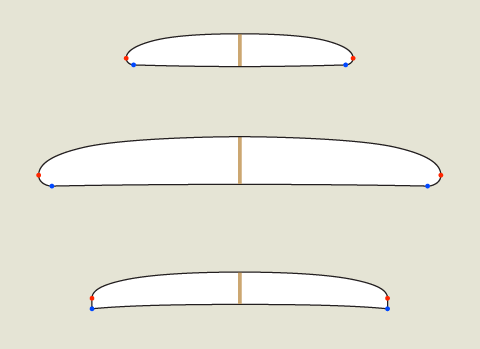|
SINGLE CONCAVES
SINGLE CONCAVES offer the surfer acceleration, projection, speed,
maneuverability and maximum control. Single concave designs are very
powerful, fast, and loose. The simple clean rail to rail arc of a single concave
offers maximum controlled lift to the rails. Water flows in a smooth arc from
rail to rail in single concaves enabling powerful, stable, and predictable
turns. The smooth rail to rail water flow enables maximum controlled power
through turns and nuanced turning radii for a wide variety of turns in
different waves. Single concaves offer maximum control and maneuverability in
critical barreling waves. Surfers can turn with maximum load off the bottom
contours and rails. Occasionally, a single concave will have a touch of double
concave or vee in the last 4" to 5" of the tail. This short double concave adds
an extra element of stability, control, and release. Moving this double concave
feature forward in the bottom contours yields the classic single to double
concave. |
|

|
|
SINGLE to DOUBLE CONCAVES
SINGLE to DOUBLE CONCAVES offer, in addition to acceleration, speed,
projection, and maneuverability, an extra element of lift to a board. As water
flows from rail the to the spine of the double concave it creates additional
lift in the center of the board. The spine along the center of a double concave
sustains the flow of water down the length of the bottom of a board maximizing
laminar flow and directional stability through turns. The peak and the depth of
the spine of a double concave can be moved forward or back and deeper or
shallower to fine tune manuverability and control. A tuned double concave
provides notable lift and reduces drag. The spine of the double concave and the
performance features it offers make the design a great bottom contour option
for the full spectrum of waves and conditions. |
|

|
|
Concaves are a radical design feature. By their nature they include
conflicting forces. When well designed and balanced with other design variables
and surfed with correct technique they generate lift and reduce drag. They
offer acceleration, projection, planning speed, maneuverability, and control -
all depending on nuanced and balanced design and surfer input. When poorly
designed or not balanced with other design variables and surfed without correct
technique they lack lift and will drag compromising all performance features.
Concaves have different configurations, different depths, and different
placement in a shape. Their radical nature allows surfers and shapers to tune
performance by their configuration. A well designed concave array maximizes
concaves' positive features - acceleration, projection, planning speed,
maneuverability, and control. |




